ESCAPE FROM COLON
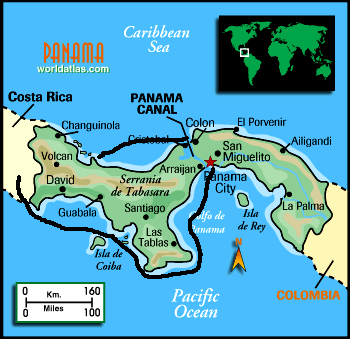 We were up early and I was
preparing the boat for rough seas. I told Dave and Larry that I felt like I was
preparing for battle. I kept going through the boat and finding things I had
missed, that might come lose and had to be tied down. Finally we were ready.
We sat and waited. We still needed to get some final clearances since we
changed our destination from Isla San Andres to Bocas Del Toro. Bocas is still
in Panama and Isla San Andres is in Columbia. We were up early and I was
preparing the boat for rough seas. I told Dave and Larry that I felt like I was
preparing for battle. I kept going through the boat and finding things I had
missed, that might come lose and had to be tied down. Finally we were ready.
We sat and waited. We still needed to get some final clearances since we
changed our destination from Isla San Andres to Bocas Del Toro. Bocas is still
in Panama and Isla San Andres is in Columbia.
Tina sent a guy to help us and
he arrived at the boat about 11:00. We were planning to get out of here by noon
so time was running short for our schedule. Larry asked him how long it would
take and he said a few hours. Larry asked if another $20 would make it faster.
He said he’d try but everyone takes siesta for lunch about this time. He’d see
what he could do. We told him we needed to leave at least by 1:00.
The hysterical woman with the
long hair came by again with her son and asked if we were still going. I said
“Definitely!” I tried to cut the conversation short with her because I didn’t
want to be influenced by all the bad stories she and her son were telling me. I
had myself so geared up to go no matter what and I didn’t want her getting me
nervous again. Her last words again were, “We’ll try and save the dock space
for you!”
Tina’s guy was back much sooner
than I expected. I asked him how he got everything done so quickly, and he
smiled and held up the cell phone. I guess he interrupted everyone from their
lunches to clear us out but it was going to cost Larry another $20. That was
fine with us as we were desperate to get out of this place.
It wasn’t a few minutes later
and we had the lines untied and were heading out of this place. It was hard to
tell how the weather was at the docks because you were protected from the winds
and swells. Once we came around the channel to the “flats” we could see that
the conditions were much better.
Again, Dave called Cristobel to
let them know we were going into the canal channel and out through the
breakwater. This time the waves weren’t breaking over the breakwater. We
edged ourselves out and it was not anything like the other day. There were some
huge swells and they seem to come from several directions. This is probably
because of the shelf beneath us that is shallow and as the waves come from the
deeper water to the shallow, it creates chaos.
I held on with white knuckles
ready for anything. Larry kept saying over and over, “It’s not nearly as bad as
I thought it would be.” After about the third time he said that I said, “Quit
it or you are going to jinx us!” Once we got farther out past all the
freighters that were anchored and waiting for their turn to go through the
canal, it got calmer and calmer. We were also correct in that our direction to
the west was much easier than if we were heading north to Isla San Andres. The
swells were coming on our port hindquarter and we could deal with that.
As the day went on, I was
totally relaxed, and had to think about the craziness that went on in that place
called Colon. The woman and son that said they’d save the dock space for us
hailed us on the radio about an hour out and asked how it was going. We told
them fine and said we would probably see them somewhere on long the way, in the
next few weeks. They said goodbye but there was a sense of disappointment that
we were leaving and they weren’t I think. I don’t know if that’s true but maybe
they were wishing we'd have to turn around and come back. Somehow I can
understand how it makes it worse for them when they stay and see someone else
leave.
The rest of the cruise was non
descript. I did watch from about 4:30 to 9:00 that evening hoping that that
would give Dave and Larry enough rest to do the night watch. Larry woke me at
3:00 AM, but I’m ashamed to say I told him I was too tired to do the 3:00
shift. I’m really not cut out for these trips when we are short handed. I
think the stress of the last few days did me in also.
BOCAS DEL TORO
 We put Rains’ waypoints in to
enter the opening into Bocas Del Toro before we left Colon. We had called to
get a reservation at Bocas Yacht Club & Marina from Colon. We told them we’d be
in about 7:00. We said we would hail them on the radio when we got to the outer
buoy. We put Rains’ waypoints in to
enter the opening into Bocas Del Toro before we left Colon. We had called to
get a reservation at Bocas Yacht Club & Marina from Colon. We told them we’d be
in about 7:00. We said we would hail them on the radio when we got to the outer
buoy.
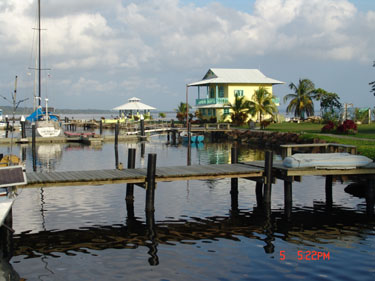 We arrived right on schedule
and as we approached the outer buoy between Isla Colon and Isla Bastimentos we
hailed the marina but got no response. We decided to follow Rains waypoints and
head in to the buoy marked channels. It was pretty stressful at first because
Rains said to not follow the buoys, as they need to be replaced, due to silting
and movement due to earthquakes. Most of his comments were related to boats
drawing more than 10’ which ours does not but still I was a little concerned.
It just goes against the grain going outside the buoys. As we went in farther
and farther it became apparent that the area must be regularly dredged now as
the depths were well beyond 40 feet deep. (And after we were here for a few
days, we would see the huge Chiquita Banana Freighter and others going in and
out through this channel). As we passed most of the buoys and were close to the
south end of Cayo Carenero Island we were able to rouse someone from the
marina. They said to proceed on to red buoy 14 and then slowly turn right and
come straight towards the ferry dock. The voice on the radio said he would meet
us there in a launch and we could then follow him in to the Bocas Yacht Club
Marina. We arrived right on schedule
and as we approached the outer buoy between Isla Colon and Isla Bastimentos we
hailed the marina but got no response. We decided to follow Rains waypoints and
head in to the buoy marked channels. It was pretty stressful at first because
Rains said to not follow the buoys, as they need to be replaced, due to silting
and movement due to earthquakes. Most of his comments were related to boats
drawing more than 10’ which ours does not but still I was a little concerned.
It just goes against the grain going outside the buoys. As we went in farther
and farther it became apparent that the area must be regularly dredged now as
the depths were well beyond 40 feet deep. (And after we were here for a few
days, we would see the huge Chiquita Banana Freighter and others going in and
out through this channel). As we passed most of the buoys and were close to the
south end of Cayo Carenero Island we were able to rouse someone from the
marina. They said to proceed on to red buoy 14 and then slowly turn right and
come straight towards the ferry dock. The voice on the radio said he would meet
us there in a launch and we could then follow him in to the Bocas Yacht Club
Marina.
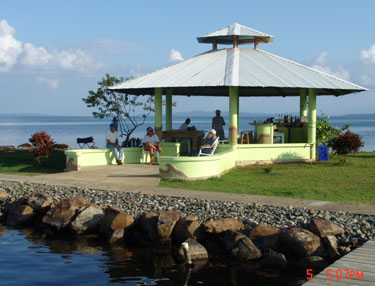 We carefully followed
directions being aware that there are shallow areas here by the light blue color
of the waters. We saw Ricardo (the voice on the radio) waiting for us and he
lead us in to the marina by keeping snug to the buildings on our right for
several hundred yards and then we turned towards the marina. We carefully followed
directions being aware that there are shallow areas here by the light blue color
of the waters. We saw Ricardo (the voice on the radio) waiting for us and he
lead us in to the marina by keeping snug to the buildings on our right for
several hundred yards and then we turned towards the marina.
There were several people on
the dock waiting to help us into the slip. Ricardo by now was on the dock and
Bill the dock manager and a few other cruisers all helped. I was so thrilled to
be here and the place was beautiful. New concrete docks, plenty of power,
showers, laundry, an open-air bar, marina office, grass and lawn, and friendly
people. We told them we were so happy to be here and how beautiful it was.
They told us they had happy
hour everyday at 4:30 and that the town had 43 restaurants. They said that
Ziggy will like the resident dog that loves to play and I said we’d see how that
goes. We could see the town from our slip and it looked like it was going to be
fun to explore. Launch taxis were coming in and out picking up and dropping
people off. Some little native children paddled by in their dugout. I think I
was going to like this place and we thought we’d stay awhile.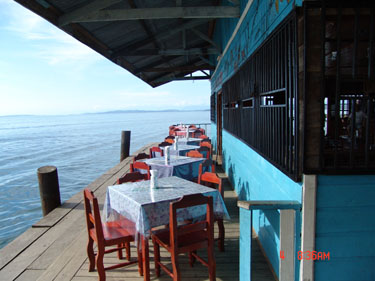
Dave went off to see what
arrangements he could find for getting a plane out tomorrow. He soon came back
from the marina office and all the flights were booked for tomorrow but there
was one stand by seat possibly available this afternoon. Dave had just enough
time to shower, pack and go to town with us to have lunch and walk around a
little. We were sorry that the flights didn’t work out better for him so that
he could enjoy the town after that stay in Colon.
It was easy to like this place,
as everything was fun and interesting. The town was a quick easy jaunt in the
dinghy and the marina had their own place to tie up at the Reef Restaurant dock
by the ferry landing. It was one of the best places in town to eat and drink
and had a constant breeze that kept you cool and comfortable. It also had the
best view of the boats and people going back and forth. 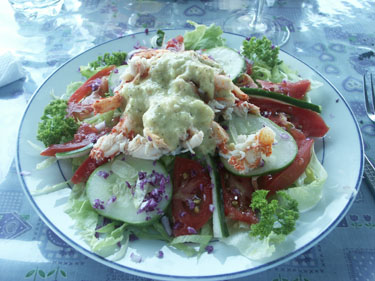 I had a great lobster
salad that was huge for $7.00 and Larry had a plate of Caribbean style chicken
and rice with vegetables. You can wash everything down with Panamanian beer
that goes down like water. They have a custom of bringing the beer to you with
a paper napkin cleverly curled around the top to keep the opening clean I
guess. They did that in Colon also. I had a great lobster
salad that was huge for $7.00 and Larry had a plate of Caribbean style chicken
and rice with vegetables. You can wash everything down with Panamanian beer
that goes down like water. They have a custom of bringing the beer to you with
a paper napkin cleverly curled around the top to keep the opening clean I
guess. They did that in Colon also.
After lunch, we walked Dave up
the long street towards the small airport and I immediately fell in love with
the place and it’s old rickety wooden buildings. This was going to be fun. The
airport was small and had one airline called Panama Pearls (pearl). We thanked
Dave and got him settled and headed back to the boat to get some rest and well,
maybe stop our marina bar for happy hour! I knew this was going to be a happy
place as the colors were brighter on the buildings.
BOCAS MARINA AND YACHT CLUB
This is an oasis for cruisers.
Elaine who manages the marina runs the place like a ship. The services are
immaculate and fine-tuned. 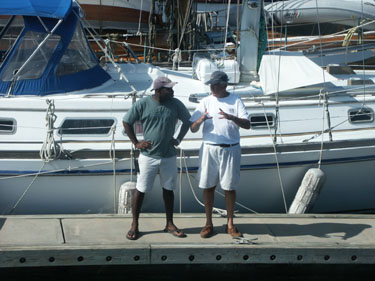 Bill and Elaine are always around and available and
making sure things are right. They have workers constantly manicuring the
grounds, painting, repairing and others to help the cruisers with whatever they
might need. Rosie does the laundry and charges by the load and things are
returned clean and professionally folded within hours. Ricardo does just about
everything and is a really nice guy. He brings his younger two brothers and
finds jobs for them too. Ricardo washed our boat when we arrived and cleaned
the underside of our boat. He takes the oil and dumps it when you change your
oil. He took our propane tank to Admiralty to fill it. He’s just great. He
helped an older Italian couple get their boat ready ad clean to leave it for 8
months here. He is a hard worker and solves all the problems. He’s an
enterprising young man and will go a long ways here. Bill and Elaine are always around and available and
making sure things are right. They have workers constantly manicuring the
grounds, painting, repairing and others to help the cruisers with whatever they
might need. Rosie does the laundry and charges by the load and things are
returned clean and professionally folded within hours. Ricardo does just about
everything and is a really nice guy. He brings his younger two brothers and
finds jobs for them too. Ricardo washed our boat when we arrived and cleaned
the underside of our boat. He takes the oil and dumps it when you change your
oil. He took our propane tank to Admiralty to fill it. He’s just great. He
helped an older Italian couple get their boat ready ad clean to leave it for 8
months here. He is a hard worker and solves all the problems. He’s an
enterprising young man and will go a long ways here.
There’s an interesting group of
people here. There are several nationalities, French, Italian, New Zealand,
Canadian, and American. There’s a boat from Newport Beach and another from San
Diego. We were also surprised at how long people have remained here with out
even planning too.
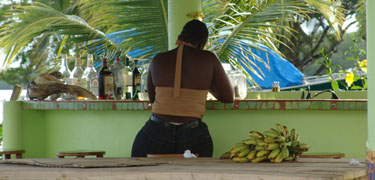 I guess they come and fall in love with it and decide not to
eave – that simple. I guess they come and fall in love with it and decide not to
eave – that simple.
Bill the manager, is a very
likable man. He’s white haired and red-faced looks like a dead ringer white
Morgan Freeman. He even talks like him. He’s from Sacramento Delta area and
has settled here. Elaine used to manage a marina in Majorca until it got too
crowded and came here. She’s spunky and friendly and gets things done. A
beautiful blond but with a strut that means business.
The older Italian couple is
from Sicily and love to spend months in the San Blass Islands. They had heard
this was a good safe place to leave their boat and I think they are finding out
that this is going to work out really well for them. We wouldn’t think twice
about going home and leaving our boat here as we watch how well they watch over
everything.
There’s a large catamaran on
the finger dock. 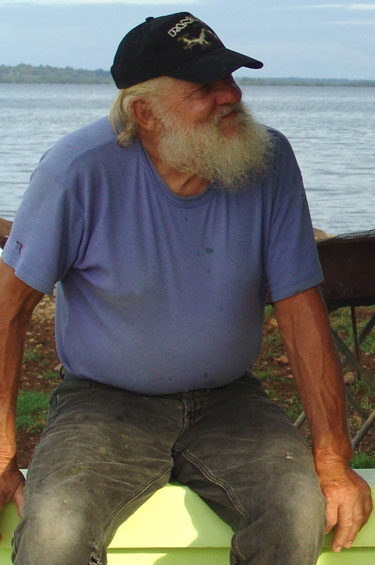 An old guy with a white beard lives on it. He’s got a
barrel-sized chest, arms like a 20 yr old and is missing his front teeth.
Apparently he is a treasure hunter by trade. He must have done well from the
size of his boat. He said he found an Old Spanish galleon off the coast of
Texas in the 60’s. There’s another treasure hunter at the end of our dock. His
boat is a little funkier looking but is more like a working vessel. Tom told us
that he has done some research diving in the Rio Dulce area in Guatemala for
National Geographic and the Smithsonian Institute. Everyone says he’s
scavenging around the area and so far has only found old bottles and such. This
area has a lot of history and Columbus had been known to frequent the island and
use the shallow waters to do repairs on their sailing ships. It also was a
haunt for pirates at one time too. In fact, one morning the marina found an old
anchor on the bottom near our boat. They hauled it out and it’s now serving as
a conversation piece at the bar. An old guy with a white beard lives on it. He’s got a
barrel-sized chest, arms like a 20 yr old and is missing his front teeth.
Apparently he is a treasure hunter by trade. He must have done well from the
size of his boat. He said he found an Old Spanish galleon off the coast of
Texas in the 60’s. There’s another treasure hunter at the end of our dock. His
boat is a little funkier looking but is more like a working vessel. Tom told us
that he has done some research diving in the Rio Dulce area in Guatemala for
National Geographic and the Smithsonian Institute. Everyone says he’s
scavenging around the area and so far has only found old bottles and such. This
area has a lot of history and Columbus had been known to frequent the island and
use the shallow waters to do repairs on their sailing ships. It also was a
haunt for pirates at one time too. In fact, one morning the marina found an old
anchor on the bottom near our boat. They hauled it out and it’s now serving as
a conversation piece at the bar.
Another couple we met had their
granddaughter with them. They are buddy traveling with another catamaran with a
nice guy from Texas. He met a black girl in Trinidad and she been with him ever
since. This pair of boats has buddied together all through the Caribbean
Islands, Columbia and now is heading up the Panama Coast on their way to Rio
Dulce. I wondered how the granddaughter fits in to all of this. The woman said
she adapts well and is being home schooled. She’s only about 7 and she says
that she speaks Spanish, English and a little French. She said the hard thing
for her is that they constantly move and each time she meets new friends it’s
time to go again. I can’t help thinking that’s got to be hard on her.
Many of the people we meet here
are just passing through and end up staying months. I can see why. It’s like a
big family.
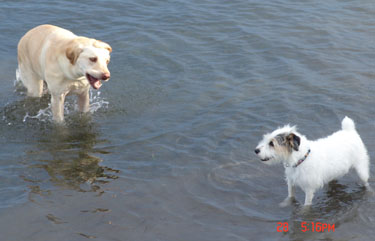 Zig has managed to get along
with the resident dog and another cruiser’s dog, a golden lab, name “Elvis”.
They are both about the easiest going dogs and have not been bothered by Zig’s
idiosyncrasies. It’s fun to watch each afternoon as everyone gathers for happy
hour and the dogs gather too and play. One day, we didn’t go down or were late,
and the little resident marina dog came to the boat and barked for Ziggy to come
out. When they get hot from playing too much, they wade into the clear water by
the bar. Zig has managed to get along
with the resident dog and another cruiser’s dog, a golden lab, name “Elvis”.
They are both about the easiest going dogs and have not been bothered by Zig’s
idiosyncrasies. It’s fun to watch each afternoon as everyone gathers for happy
hour and the dogs gather too and play. One day, we didn’t go down or were late,
and the little resident marina dog came to the boat and barked for Ziggy to come
out. When they get hot from playing too much, they wade into the clear water by
the bar. 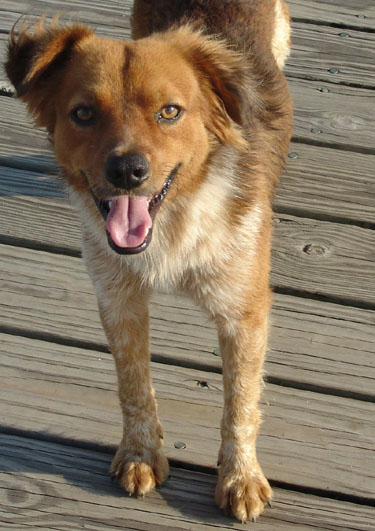 Everyone here understands Zig and knows he’s a little eccentric but
they don’t mind. They all call him by name and he is having a ball here. If
something around the marina doesn’t look normal, the three dogs all join
together to investigate and bark to announce to all that something isn’t right.
One day a huge boat came in, about 120 ‘, and they immediately got down their
obnoxious jet skis and were Everyone here understands Zig and knows he’s a little eccentric but
they don’t mind. They all call him by name and he is having a ball here. If
something around the marina doesn’t look normal, the three dogs all join
together to investigate and bark to announce to all that something isn’t right.
One day a huge boat came in, about 120 ‘, and they immediately got down their
obnoxious jet skis and were
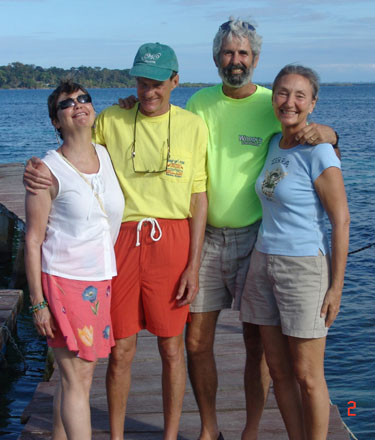 making noise and racing around. None of the rest of
us liked it nor did the dogs I guess because they were the only ones with balls
enough to tell them. making noise and racing around. None of the rest of
us liked it nor did the dogs I guess because they were the only ones with balls
enough to tell them.
We made friends with one of the
cruisers and his name is Tom. He’s from Shreveport, LA. We liked him
immediately. He was alone waiting for his wife to come back from the states.
He’s a real character with a twinkle his eye and funny stories. He and his wife
have cruised extensively in Central America for many years. He’s an easygoing
guy and nothing bothers him even the chitras (little black flies or no see
ums). He can sit on his boat in the heat and be happy as a clam. Meanwhile,
Larry and I are covered in bites and itching until they bleed. That’s the one
big draw back for me is the bugs, those little rascal “no see ums”. I’ve got
them under control now, but you have to spray yourself religiously with bug
spray or forget it. I mean every exposed square inch has to be sprayed or
they’ll get you.
The only other thing that is a
bit troublesome is the water. I’m told it’s town water and that it’s so
chlorinated that you won’t have any problems but my Lonely Planet Book, under
their heading of Dangers and Annoyances, says don’t trust the water. I’ve asked
many in town that run businesses and their “pat” answer is, well I don’t drink
the water in the states or Canada so why would I drink it here.
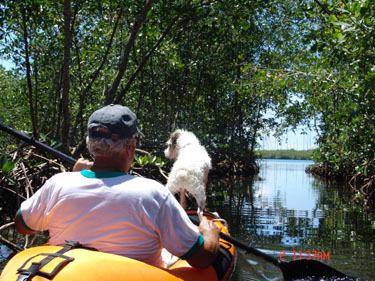 So, we have not
put the water in our water tank and decided to put several gallons of purified
bottled water in the tank until we leave. The water looks clean in the marina
but it goes against our grain to make water in a marina. Also, when I kayaked
around the corner in the mangroves there are several settlements of native
Indians that are dumping in the water and it doesn’t look too clean. So, we have not
put the water in our water tank and decided to put several gallons of purified
bottled water in the tank until we leave. The water looks clean in the marina
but it goes against our grain to make water in a marina. Also, when I kayaked
around the corner in the mangroves there are several settlements of native
Indians that are dumping in the water and it doesn’t look too clean.
On the
whole though, this is a wonderful place to come and stay. We feel safe
and comfortable. We did have one incident though. Rains had warned us never to
leave our dinghy in the water at night anywhere in Latin America. We had been
to town one morning for breakfast and a native guy was awfully interested in our
dinghy. He was asking how much it was worth and things like that. That night,
we just didn’t feel right about it and put the dinghy up on top of the boat.
The next morning, the dinghy much like ours in boat two slips down was stolen.
Elaine was very upset since this was the first time something like this had ever
happened. She felt compelled to warn everyone to secure their dinghies. Bill
said the whole town would be looking for the guy because the town doesn’t
tolerate things like this. The next day the dinghy was found by the airport and
soon later the responsible party was thrown in jail. 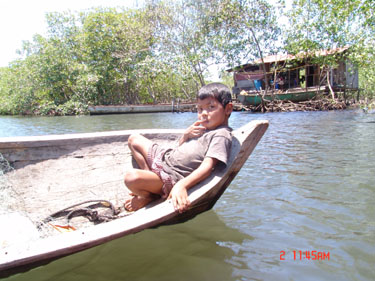 Our neighbors got their
dinghy back but the cables to the engine had been damaged and they had to order
new ones from the states. Apparently, when they steel these dinghies they are
after the motors and they can’t cut the cables on the newer ones. So I guess
they abandoned the dinghy after several tries to remove the motor and were
unsuccessful. Our neighbors got their
dinghy back but the cables to the engine had been damaged and they had to order
new ones from the states. Apparently, when they steel these dinghies they are
after the motors and they can’t cut the cables on the newer ones. So I guess
they abandoned the dinghy after several tries to remove the motor and were
unsuccessful.
We feel very safe here though
and walk through town at night and don’t worry about anything in the marina.
Everyone watches out for each other, though there is no problem.
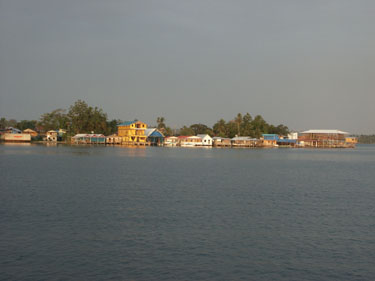 BOCAS THE TOWN, It’s a real mix BOCAS THE TOWN, It’s a real mix
I’ve been thinking for days,
how do I describe this place. It’s really difficult because as a destination to
fly down to, I don’t think I’d enjoy it as much. But as a destination on a
boat, it’s the best. I also try to think what my friends would think about this
place if they came to visit and they might think I’ve lost my marbles. But we
truly love it.
There is nothing upscale or
luxurious about this place and no shopping to speak of. The town could be
described as something you might imagine out of the Old West in the 1800’s.
It’s got a fairly wide main street that is about a half mile long and runs along
the waterfront of the Island Colon. One side of the street is built over the
water on posts. The other side is on land and there are little small side
streets behind the main street that is mostly residential with a few small inns
or stores here and there.
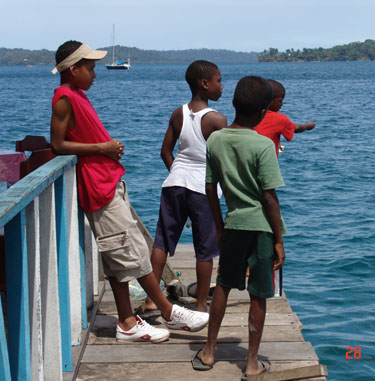
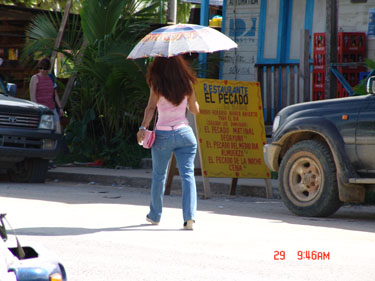
Since there is one road on the
small island, there aren’t too many cars. All the cars must come on the ferry
and I don’t think there is a gas station, as we know of them, on the island. I
think you have to purchase a can of gas and put it in by hand. Some people have
the new electric carts, others have “gators”, others have bikes, and the rest
are small taxis and beat up junkers. It’s a real mix. But mostly you just walk
down the center of the street with the dogs.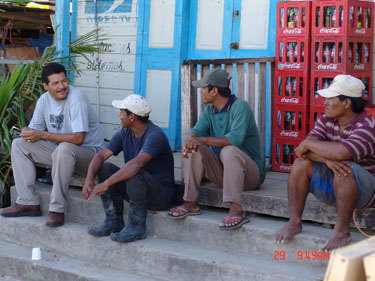
The buildings are the most
charming. They were built at the turn of the last century and some earlier
by the Banana Fruit Company. They are all wooden with old tin roofs.
The majority of them would be condemned and torn down in our hometowns, but not
here. It doesn’t matter how much they are leaning this way and that, they
are still functioning, whether a restaurant, general store, small hotel or
whatever. They have a certain charm to them. They are described in
Rains book as “Caribbean Colonial – a quaint Victorian style but modified for
tropic comfort.” Most are two story and have wrap around porches on the
upper level with intricately design railings and corbels. Many have old
broken down shutter doors and latticework designs over the transoms. Some
are weathered gray from the lack of paint over the years and others are painted
bright Caribbean colors. The floors of the entry porches are old wooden
planks just like I the old west
.
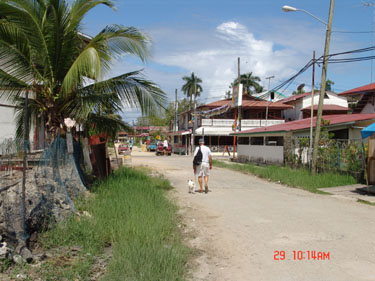 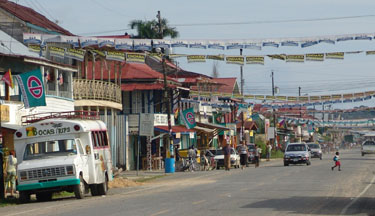
The buildings on the waterfront
side are all accessible by launch as most of the traveling around here is done
by launch or dinghy. Wherever you want to go, there are rustic docks at the
backside of these buildings. We had some favorite places to eat and we would
just drive the dinghy to them, tie it up, throw Zig up on the wooden floor and
climb up. There were water taxis available for those that didn’t have their own
mode of transportation.
WATER TRAVEL, the way to go
The water transportation is
worth mentioning. We had the fanciest dinghy in town except for another boat in
a couple slips down from us. Then there are the older dinghies that look like
they’ve been around for a while, and sometimes the more beat up it looked, the
better. They were owned by cruisers that just stay down here and cruise. A lot
of the dinghies have canvas “clothes” to protect them from the wear and tear of
the hot sun or just the dirt. Then there were the water taxis. They were long
narrow wood pongas with usually something like a Honda motor on the back. Some
were fancier than others.
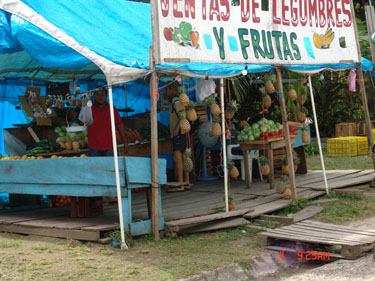 The fancier ones had a make shift sunscreen. Most
had multiple wooden planks to sit on. We saw one that must have been not more
than four feet wide and about 25 feet long. Many are painted in bright colors.
They can maneuver those things into the narrowest places like you wouldn’t
believe. Then there were the water taxis that took you to Almirante,
Bastiamentos, or Chanquinola. They were bigger in that they were wider. You
could squeeze in about four people wide and five or six rows. They were covered
in a low canvas awning and you had to crouch to get in them. Those little
stinkers could go up to 30 knots and within a short while you could be on the
mainland. Mostly natives and residents getting business done in Almirante used
those. Last but certainly not the least, were the dugout canoes. The Indians
or natives in the area used these. They were as commonplace as any of the other
modes of transportation. They were carved as you would imagine from one single
log and the paddle was handmade also. There were a rare few that would have an
outboard motor on it with a few gas cans inside. Mostly they were small and
held one or two people and one baby. They were commonplace, but I thought they
were charming. I was never bored at the site of them. I was just amazed at the
mix of everything. The fancier ones had a make shift sunscreen. Most
had multiple wooden planks to sit on. We saw one that must have been not more
than four feet wide and about 25 feet long. Many are painted in bright colors.
They can maneuver those things into the narrowest places like you wouldn’t
believe. Then there were the water taxis that took you to Almirante,
Bastiamentos, or Chanquinola. They were bigger in that they were wider. You
could squeeze in about four people wide and five or six rows. They were covered
in a low canvas awning and you had to crouch to get in them. Those little
stinkers could go up to 30 knots and within a short while you could be on the
mainland. Mostly natives and residents getting business done in Almirante used
those. Last but certainly not the least, were the dugout canoes. The Indians
or natives in the area used these. They were as commonplace as any of the other
modes of transportation. They were carved as you would imagine from one single
log and the paddle was handmade also. There were a rare few that would have an
outboard motor on it with a few gas cans inside. Mostly they were small and
held one or two people and one baby. They were commonplace, but I thought they
were charming. I was never bored at the site of them. I was just amazed at the
mix of everything.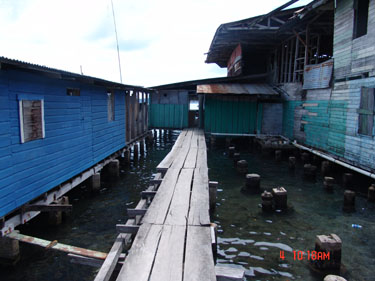
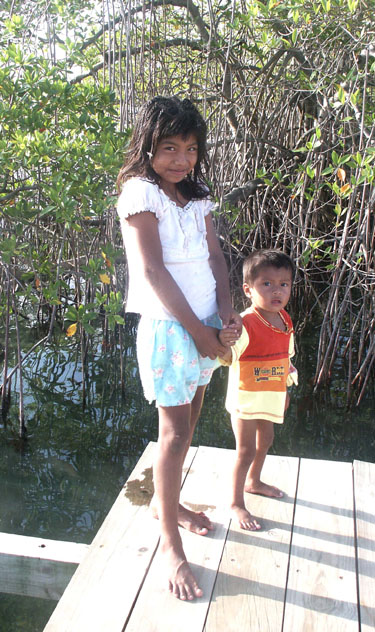 There were wood planked paths
over the walked to get you from your boat to the street. Some buildings were
mostly accessible from the water rather than the street. To reach some places
you would have to walk down a rickety-planked pathway between buildings. Some
places didn’t have signs you just had to know where it. Many signs throughout
the town were unintentionally misspelled which was comical. There were wood planked paths
over the walked to get you from your boat to the street. Some buildings were
mostly accessible from the water rather than the street. To reach some places
you would have to walk down a rickety-planked pathway between buildings. Some
places didn’t have signs you just had to know where it. Many signs throughout
the town were unintentionally misspelled which was comical.
This definitely is a tourist
town, there’s no doubt about that. They say there are 43 restaurants.
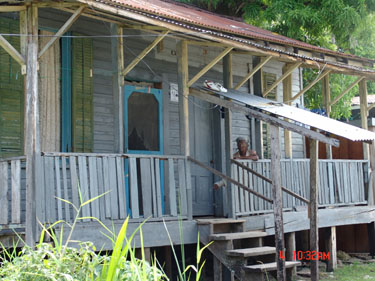 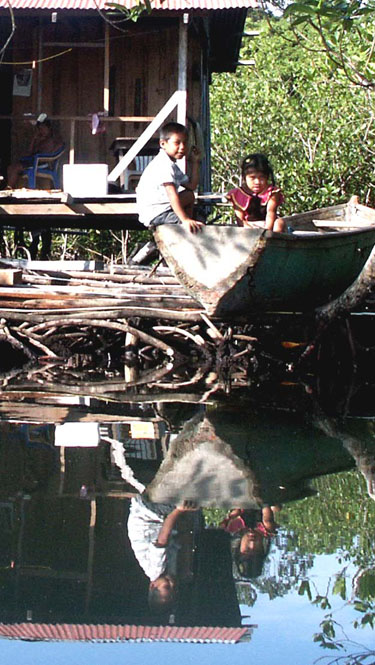 There
are many small hotels with simple minimal comforts and a few new very small
European style hotels over the water. There are a handful of general stores
that I can only compare to something out of the old west. They had old wooden
counters with glass fronts surrounding the room and tall ceilings with goods
stacked the full width and height. Some have old-fashioned scales hanging above
the counter to weigh something. There
are many small hotels with simple minimal comforts and a few new very small
European style hotels over the water. There are a handful of general stores
that I can only compare to something out of the old west. They had old wooden
counters with glass fronts surrounding the room and tall ceilings with goods
stacked the full width and height. Some have old-fashioned scales hanging above
the counter to weigh something.
In the center would be another counter with
stuff pile on top.
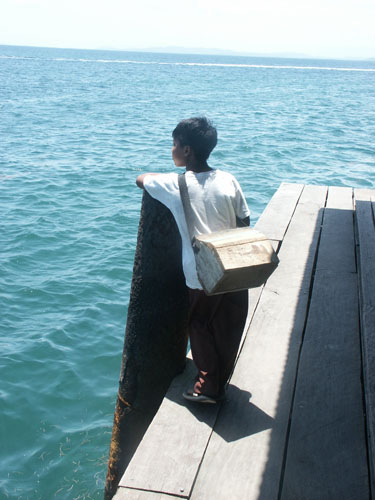 If you wanted something you had to ask the clerk to get it
for you or point to it if they didn’t understand. Each general store had a
little of this and a little of that. If you were looking for Ajax or something
like that, one store might have 2 bottles and another not have any. It was a
fun excursion just walking around town just having something to look whether you
needed it or not. If you wanted something you had to ask the clerk to get it
for you or point to it if they didn’t understand. Each general store had a
little of this and a little of that. If you were looking for Ajax or something
like that, one store might have 2 bottles and another not have any. It was a
fun excursion just walking around town just having something to look whether you
needed it or not.
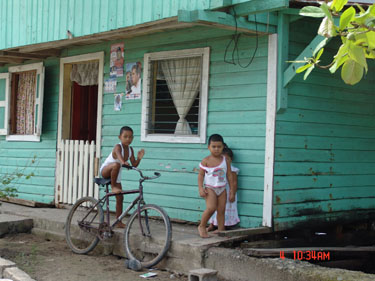 It was like a treasure hunt. I also loved walking on their
old plank floors because they were so irregular. Some of the planks would sink
slightly and others were crooked. Some would be missing and would be covered
with any old thing nailed tight. You would find everything from tools, nails in
bins (you could even buy one instead of a package that you didn’t need like at
Home Depot), to clothes, cloth, cooking oil, dishes, rice, just everything, but
probably not the one particular thing you were looking for. The fun part was
just looking for it. It was like a treasure hunt. I also loved walking on their
old plank floors because they were so irregular. Some of the planks would sink
slightly and others were crooked. Some would be missing and would be covered
with any old thing nailed tight. You would find everything from tools, nails in
bins (you could even buy one instead of a package that you didn’t need like at
Home Depot), to clothes, cloth, cooking oil, dishes, rice, just everything, but
probably not the one particular thing you were looking for. The fun part was
just looking for it.
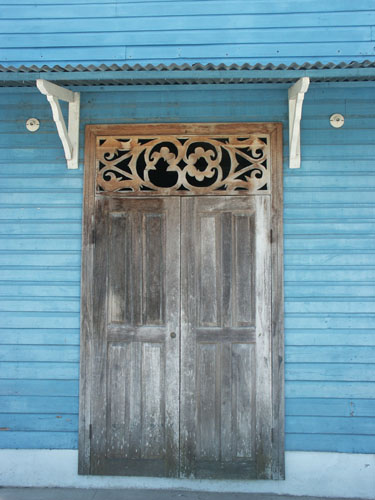
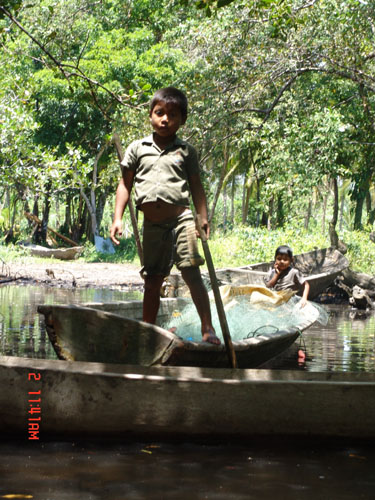
As you’ve probably surmised
there aren’t many rules around here and that probably why everyone likes it here
so much, at the implants. You’re responsible for yourself here and if you can’t
walk down the pot holed street with out falling then it’s your own damn fault. 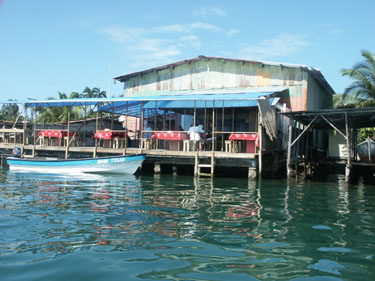 If you fall off the dock at the restaurant your eating at, it’s still your own
fault. If the building collapses that you’re eating in because it’s leaning way
too far on it’s side, it’s surely your fault. If you get bit by a dog, well, no
one knows who’s dog it is, so what’s the problem and also the dogs are so dossal
here that they wouldn’t even consider that. But if you steal, or hurt someone,
or do drugs, watch out because you’re thrown in the clinker for three months
regardless the charge. It’s a lot like the old west and I love it. It’s still
functioning in the old days when people were responsible for their own actions.
We are so worried about everything because we might get sued, but not here. If
there’s an old shack on it’s last legs, don’t worry about it, open it up and
start a restaurant. If you don’t buy furniture, just make it out of whatever’s
around, and it doesn’t matter if it’s not straight or too sturdy. One night we
ate at the Pescador Sabor on the second floor outside on the balcony. The
building was slanting so much I was worried about it falling over while we were
eating. Larry said the balcony would probably collapse under us first before
the building. The chairs were hand made and the table-top kept flipping up
since it was a piece of board wedged in the railing and on top of a post. They
covered it in a piece of oilcloth. We finally had to move to another table
because it would have flipped our food across the room if Larry forgot and put
his elbows down too hard.
If you fall off the dock at the restaurant your eating at, it’s still your own
fault. If the building collapses that you’re eating in because it’s leaning way
too far on it’s side, it’s surely your fault. If you get bit by a dog, well, no
one knows who’s dog it is, so what’s the problem and also the dogs are so dossal
here that they wouldn’t even consider that. But if you steal, or hurt someone,
or do drugs, watch out because you’re thrown in the clinker for three months
regardless the charge. It’s a lot like the old west and I love it. It’s still
functioning in the old days when people were responsible for their own actions.
We are so worried about everything because we might get sued, but not here. If
there’s an old shack on it’s last legs, don’t worry about it, open it up and
start a restaurant. If you don’t buy furniture, just make it out of whatever’s
around, and it doesn’t matter if it’s not straight or too sturdy. One night we
ate at the Pescador Sabor on the second floor outside on the balcony. The
building was slanting so much I was worried about it falling over while we were
eating. Larry said the balcony would probably collapse under us first before
the building. The chairs were hand made and the table-top kept flipping up
since it was a piece of board wedged in the railing and on top of a post. They
covered it in a piece of oilcloth. We finally had to move to another table
because it would have flipped our food across the room if Larry forgot and put
his elbows down too hard.
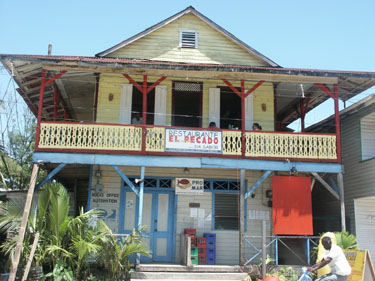 I have to remember to tell you
about this little Indian kid in town before I forget. The first day we arrived
and walked down the main street, this little kid walked up to Larry and pulled
on his shirttail and muttered something. He was probably only about eight years
old, bare foot and clothes that were so brown that they must be washed in the
muddy water. He had a hand made wooden box that was hung on his shoulder across
his chest with an old woven piece of banding. I finally figured out he was
asking Larry if he wanted a shoeshine. We were hurrying to get Dave to the
airport so Larry said another day. Now trying to find someone in this town to
give a shoeshine to is about as hard as trying to sell a wool muffler to someone
in the desert. It’s hot here and everyone where’s sandals or is barefoot. Poor
little guy, trying to earn some money, someone ought to give another idea. I have to remember to tell you
about this little Indian kid in town before I forget. The first day we arrived
and walked down the main street, this little kid walked up to Larry and pulled
on his shirttail and muttered something. He was probably only about eight years
old, bare foot and clothes that were so brown that they must be washed in the
muddy water. He had a hand made wooden box that was hung on his shoulder across
his chest with an old woven piece of banding. I finally figured out he was
asking Larry if he wanted a shoeshine. We were hurrying to get Dave to the
airport so Larry said another day. Now trying to find someone in this town to
give a shoeshine to is about as hard as trying to sell a wool muffler to someone
in the desert. It’s hot here and everyone where’s sandals or is barefoot. Poor
little guy, trying to earn some money, someone ought to give another idea.
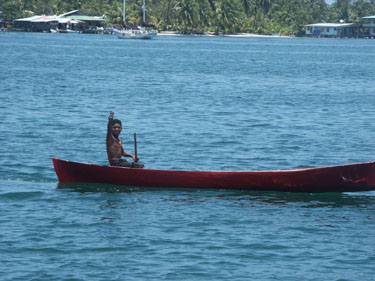 There’s one small place with a
hand painted sign out front called “Costco”. It can’t be any bigger than 10-12
feet wide and 20 feet deep and most of the wares are stacked on the street. He
sells in bulk. In other words, if you want a coke you buy a flat of cokes, or
rice, you buy a box of 20 packages of rice. I think you could save 2 cents.
We didn’t find much use for that place but loved the name. There’s one small place with a
hand painted sign out front called “Costco”. It can’t be any bigger than 10-12
feet wide and 20 feet deep and most of the wares are stacked on the street. He
sells in bulk. In other words, if you want a coke you buy a flat of cokes, or
rice, you buy a box of 20 packages of rice. I think you could save 2 cents.
We didn’t find much use for that place but loved the name.
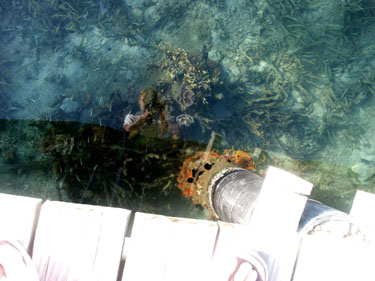
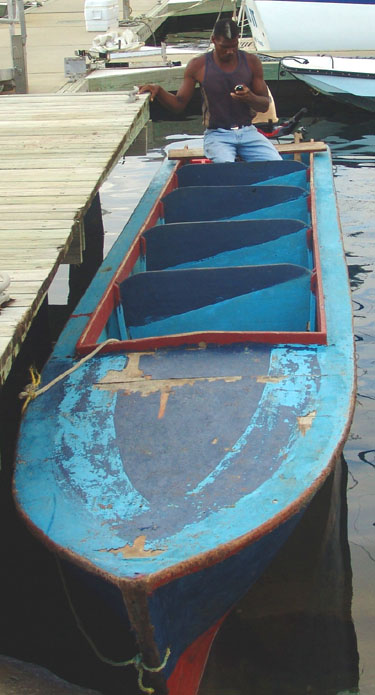
You bought your fruit and
vegetables from several makeshift stands scattered throughout town. They are
much like you would imagine farmer’s stands at home but theses all carry the
same supply of things. It depended on what came in on the ferry that week.
The usual assortment was: ice berg lettuce, great tomatoes, celery, bell
peppers, onions, potatoes and carrots for veggies. The fruits varied as some
days you could get pineapples, or mangos, plantains, bananas and other days it
was just a few items. They have great limes that are orange inside and very
juicy. Nothing is refrigerated of course or clean. So many times the lettuce
and celery is wilted and beyond it’s time before you can even buy it. These
regular mixtures of fruits and vegetables are what you found served in the
restaurants too. They all have the same source for food products. So a salad
would be iceberg with the same tomatoes and cucumber and the same carrots, rice
and potatoes served a gazillion different ways.
There were two, what they call
super markets in town. One was on the far end from our marina and had no charm
whatsoever. The boxed goods looked old and dusty, and the vegetables were old.
The potatoes and carrots were on the limp soft side. They had a meat
refrigerator with raw meats but the outside was dirty so it didn’t say much to
me for the cleanliness of the inside. I did see one whole chicken that I
thought I might buy if I got desperate.
 There is one place that touts
the name of “Gourmet Market” owned by a transplant from Louisiana. There you
can find some amazing things that you won’t see in the local stores, like
camembert, feta cheese, frozen scallops, tortillas, many canned goods, etc.
She also carries fresh bread and cinnamon rolls from the local European Bakery
that we discovered late in the game that makes the best stuff. There is one place that touts
the name of “Gourmet Market” owned by a transplant from Louisiana. There you
can find some amazing things that you won’t see in the local stores, like
camembert, feta cheese, frozen scallops, tortillas, many canned goods, etc.
She also carries fresh bread and cinnamon rolls from the local European Bakery
that we discovered late in the game that makes the best stuff.
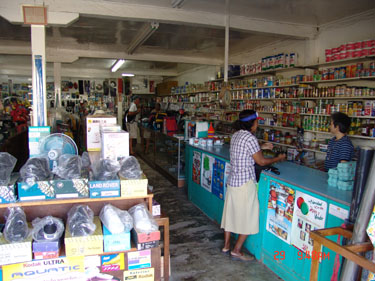
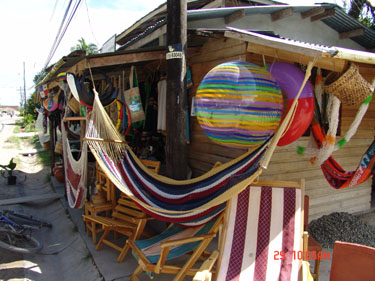
The other “super market”
(which both by the way were the size of a typical 7-Eleven as we know them) was
new and not quite fully operating when we were there. A Chinese family owned
it. It was clean as could be and the whole family was working for two weeks
putting all the goods perfectly on the shelves. Everything was lined up in
straight rows and dusted and new. I did buy some frozen chicken breasts there
that I thought looked clean and maybe fresh until the owner reached in the
refrigerator with his bare hands, bagged them for me, and then went out to
continue restocking the shelves without washing his hands.
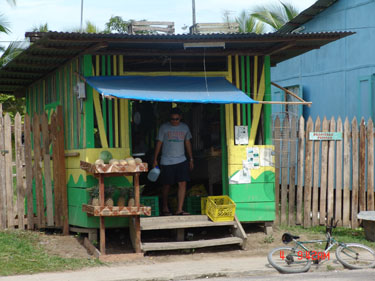
That’s about describes the
health codes around here, there are none. One open air bar on the waterfront
had a boa constrictor in a glass cage as you walked by the narrow planking to
get in and then behind the bar was a baby white face monkey that was sucking on
all the fruit garnishes for the pina coladas. He was cute as a bug but I didn’t
want to expose us to what sort germs might be growing there. I do wonder how
safe it is to eat in the restaurants, but they are all busy, and so far no
problems.
The restaurants are many and
quite rustic except for a couple that I’d say were on the verge of being a notch
up from rustic. Food is cheap. We can have a meal in town for about $4 and a
huge lobster salad for $7 although that is not our intention to find a cheap
meal. 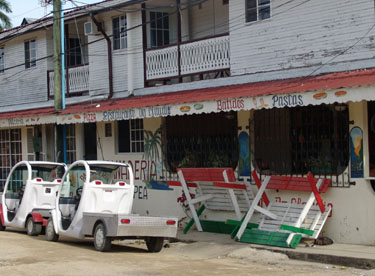 In fact our intention is to find a fancy meal. The fanciest we found was
at the original United Fruit Company Hotel near the plaza. This place is very
small but has been meticulously restored by the present owner to its full
“rustic splendor” of the old days. We loved sitting out on the front porch,
practically on the street and enjoying a real glass of Chilean wine and
wonderful Italian food. We could watch the world go by and our waiter (the only
water) who preferred being called “Nino” rather than his real name “Jesus” was
friendly and waited on us like we were his only customer (which we usually
were). We also enjoyed the “Ballena” next door that coincidently served
“authentic” Italian food also. In fact our intention is to find a fancy meal. The fanciest we found was
at the original United Fruit Company Hotel near the plaza. This place is very
small but has been meticulously restored by the present owner to its full
“rustic splendor” of the old days. We loved sitting out on the front porch,
practically on the street and enjoying a real glass of Chilean wine and
wonderful Italian food. We could watch the world go by and our waiter (the only
water) who preferred being called “Nino” rather than his real name “Jesus” was
friendly and waited on us like we were his only customer (which we usually
were). We also enjoyed the “Ballena” next door that coincidently served
“authentic” Italian food also.
The restaurants menus, though
listed many items, really were limited to what the ferry brought in that week.
One of our favorite little breakfast joints over the water, though it had bacon
on the menu, couldn’t serve it one day as he simply said “ there’s no more bacon
in town” until the ferry comes. He apologized and said he searched all over
town and there is none.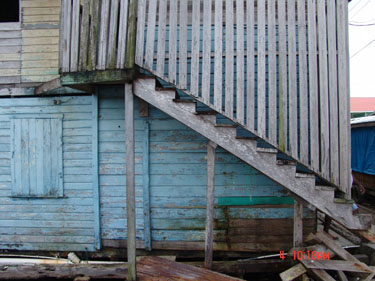 Some of the restaurants are for the natives and they
are mixed in with everything else in town. One day I saw a guy cooking on a
card table. He had a big bucket of soup ad some meat on a charcoal grill. He
has a few chairs and crates for a table. There’s another place near the plaza
that cooks BBQ’d chicken and serves it to you in a brown paper bag. Everything
works, not matter what style. Some of the restaurants are for the natives and they
are mixed in with everything else in town. One day I saw a guy cooking on a
card table. He had a big bucket of soup ad some meat on a charcoal grill. He
has a few chairs and crates for a table. There’s another place near the plaza
that cooks BBQ’d chicken and serves it to you in a brown paper bag. Everything
works, not matter what style.
There is a mix of people here
too. There are quite a few blacks left over from the slave trade, and working
on the Panama Canal. There are many native Indians that live in the huts in the
mangroves nearby. The town has a growing community of Europeans, Americans and
Canadians. There are a couple Chinese families in town and they have a Chinese
restaurant and the small new supermarket that I mentioned.
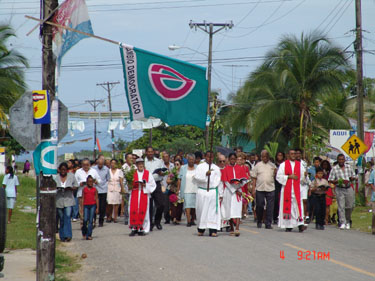 What’s really great
is that everybody mixes with everybody. There is no friction that I can see. They all mix together and seem a happy bunch. What’s really great
is that everybody mixes with everybody. There is no friction that I can see. They all mix together and seem a happy bunch.
Occasionally, there is a
theft or trouble in town but the whole town becomes involved to find out the
culprit and he automatically gets thrown in jail for 3 months no matter what the
offense. While we were here the dinghy a couple slips down was stolen. It was
almost identical to ours but we happened to put our on top of the boat that
night because someone was asking us too many questions about it in town that
day.
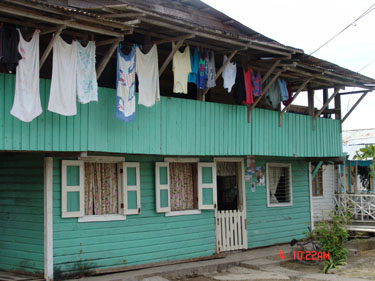 The whole town knew about the theft and kept an eye out for the thief.
The next day the dinghy was found near the airport and returned and we heard the
culprit was thrown in jail. They say they don’t tolerate things like that here. The whole town knew about the theft and kept an eye out for the thief.
The next day the dinghy was found near the airport and returned and we heard the
culprit was thrown in jail. They say they don’t tolerate things like that here.
We feel perfectly safe here and
enjoy walking through town after dark. Everyone enjoys the town and walk freely
down the middle of the street. The dogs enjoy the same freedom as they are all
running around lose. We haven’t found a mean dog yet, actually Ziggy is the
meanest dog in Bocas Del Toro. Many hang out at the central plaza and enjoy
sitting on the concrete benches and watch the world go by. They are all
friendly and respond to a “Hola” with a big smile.
Bocas Del Toro is
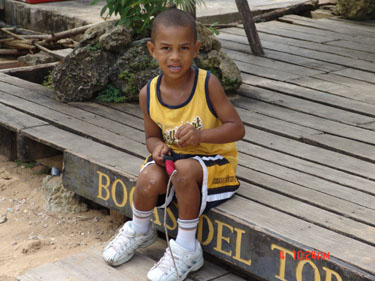 on the Island
of Colon, which is one of a cluster of beautiful island here. The waters are
crystal clear if there have been no rains causing the many rivers to dump silt
into the area. The surfing is said to be great also. One of the islands touts
the rare red frog that is only found there and no where else on this planet.
There are many nearby excursions that are very inexpensive to snorkel and go to
pristine beaches. on the Island
of Colon, which is one of a cluster of beautiful island here. The waters are
crystal clear if there have been no rains causing the many rivers to dump silt
into the area. The surfing is said to be great also. One of the islands touts
the rare red frog that is only found there and no where else on this planet.
There are many nearby excursions that are very inexpensive to snorkel and go to
pristine beaches.
Our new friends from Louisiana
and had guests fly in and they visited the mountain areas on the mainland for a
few days and we were told they were spectacular with perfect weather conditions
in the 70’s, wonderful farm lands growing Riverside, CA oranges, strawberries,
and other delicious treats. They visited an orchid farm that had hundreds of
rare orchids and one in particular was the Dracula Orchid a fantastic black on
with a red center. Lots to see around here if you have the time. The marina is
a perfect place to leave your boat and go do some of these things, as they take
great care of your boat.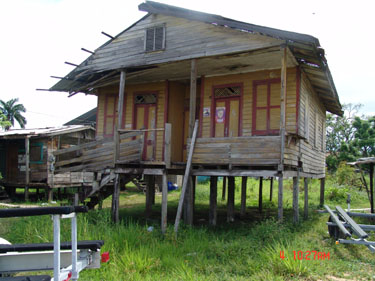
That about describes this place
that we fell in love with. We think it won’t be this way for long because many
gringos and others are coming in and starting to develop. There’s a mad rush of
people flying down here just to buy land. It like the gold rush. I hate to see
this turn into a Cancun but I’m afraid that might happen.
BANANA FIELDS OF CHANQUINOLA
DAY-O, DAY-AY-AY-O
DAYLIGHT COME AND ME WAN’ GO
HOME
WORK ALL NIGHT ON A DRINK OF
RUM
STACK BANANA TILL DE MORNING
COME
COME MISTER TALLY MAN, TALLY ME
BANANA
LIFT SIX FOOT, SEVEN FOOT,
EIGHT FOOT BUNCH
BEAUTIFUL BUNCH OF RIPE BANANA
HIDE THE DEADLY BLACK TARANTULA
Sung by Harry Belafonte
At the
suggestion of Tom, from Louisiana, we took the fast taxi to Chanquinola. What an
adventure. For the amazingly inexpensive cost of $5 per person each way we had
a fantastic time.
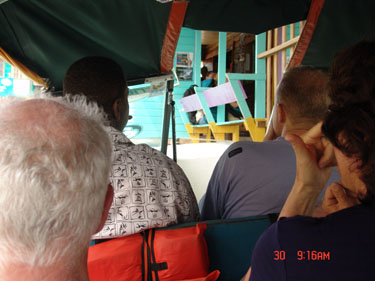 In the late 1800’s the Snyder
Bros. Started cutting a channel parallel to the ocean to barge out the bananas
from the vast banana plantations here. The channel is about 15 km long and is
amazing. It’s about 40 wide at the widest part and cut straight through the
jungle. Not realizing this is a great tourist ride, the local water taxi
service offers a quick trip up to Chanquinola through this channel. Many locals
use it to get the Chanquinola that has a lot of local shopping and also another
30-minute taxi ride people can get to the border of Costa Rica. Those who are
transplants living here have to get out of the country every 90 days for 72
hours. At this borders for $20, under the table, they can get their passports
stamped and turn right around and get back to Bocas in another hour with out
having to stay overnight in Costa Rica. Today we used it for an adventure
ride. In the late 1800’s the Snyder
Bros. Started cutting a channel parallel to the ocean to barge out the bananas
from the vast banana plantations here. The channel is about 15 km long and is
amazing. It’s about 40 wide at the widest part and cut straight through the
jungle. Not realizing this is a great tourist ride, the local water taxi
service offers a quick trip up to Chanquinola through this channel. Many locals
use it to get the Chanquinola that has a lot of local shopping and also another
30-minute taxi ride people can get to the border of Costa Rica. Those who are
transplants living here have to get out of the country every 90 days for 72
hours. At this borders for $20, under the table, they can get their passports
stamped and turn right around and get back to Bocas in another hour with out
having to stay overnight in Costa Rica. Today we used it for an adventure
ride.
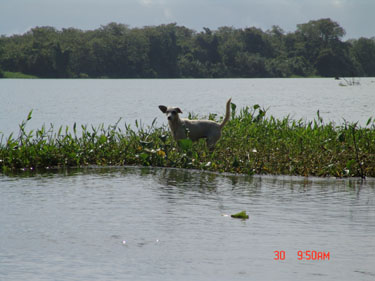
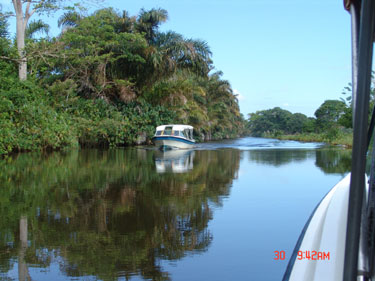
The taxi loaded about 30 people
into this small cramped launch with a low canvas sun cover. When it was
completely full and low to the water they took off at the speed of light to
circumvent the southern half of Colon Island and then head across the cut to the
mainland where I swear he looked like he was going to beach the boat full speed
into the land when at a quick moment there was a slight opening and he made the
quick turn into this manmade channel.
His speed never dropped from
what we estimated as 30 knots even in this narrow channel. It was s straight
cut just inside the ocean side facing the Caribbean. There were tree branches
cascading over the channel and views into the jungle. We sped past small
primitive huts perched on poles above the muddy wetlands, and dogs barking at us
running around on suspended planks underneath the huts. Nearby we would get
quick glimpses of pigs and steers grazing and the cockedoodle of roosters. As
we passed one hut the smell of roasted pig was intoxicating.
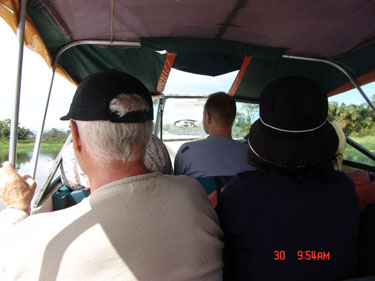 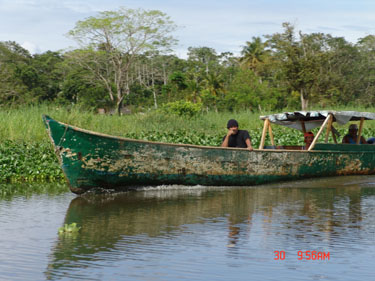
The landscape was varied
between mangroves, and tropical palms and large tall spreading trees creating a
canopy above us. There were various herons, grey and white.
We went along this straight for
quite a ways and then came upon and wide opening which was a fork in the
channel. Our mad driver took the path to the right without a moment’s
hesitation. The large open area was covered in various kinds of exotic lily
pads and lime green grasses swaying in the ocean breeze.
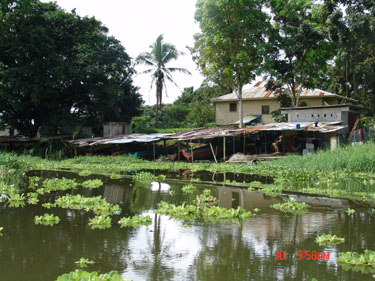
To our right now we were
getting glimpses of the great Caribbean and the wind battered beach littered
with piles of weathered grey logs. The sand was a blackish grey color and the
light sun bleached wood stood out against the backdrop. Before we could get
tired of this scenery the driver slowed down for the first time and carefully
crossed over to enter a smaller more natural channel. I assumed he slowed down
because there was a hut there, like the others, but the family was by the water
working on something, and he didn’t want to create a wake for them. The family
dog, white, but brown with mud came romping out through the wet grasses and told
us to stay away and not get to close.
Soon, the driver picked up
speed again and we passed wonderful scenery. At one point we passed the water
taxi going the opposite direction and they both slowed to almost a halt as the
silently passed each other both full with people. Not a nod or wave was
acknowledge between either and then the accelerato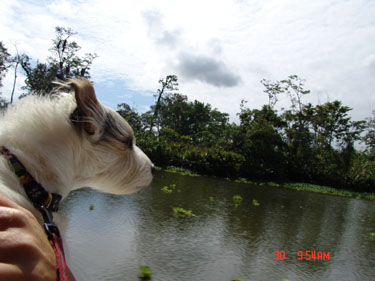 r activated to the maximum
again. e passed some villagers, trying to hug the side of the channel to make
way for our wake. They were coming from Chanquinola I imagined with some
supplies. r activated to the maximum
again. e passed some villagers, trying to hug the side of the channel to make
way for our wake. They were coming from Chanquinola I imagined with some
supplies.
Soon, we slowed down and could
see the taxi station dug into the mud side of the channel. It was a rustic hut
with planks to unload the people on and a tin roof giving it protection from the
hot sun and probably the torrential rains in the wet season.
We were immediately greeted by
little children with dirty faces and tattered clothes asking us for something
that we didn’t understand. The driver shooed them away and then we were
accosted by the taxi drivers asking “the border?” We asked one to take us to
Chanquinola. He directed me across the small park that was nearby so that I
would cross on the concrete path and not get my shoes dirty and as we were
walking that way he crossed himself across the mud.
We got in the car and headed
towards Chanquinola on about the worst pot holed rode we’d seen since we arrived
in Central America. His slow progress over these potholes allowed us to see the
surrounding area though. We realized that we were smack center in a banana
plantation or I guess now days it’s the Chiquita Banana corporation.
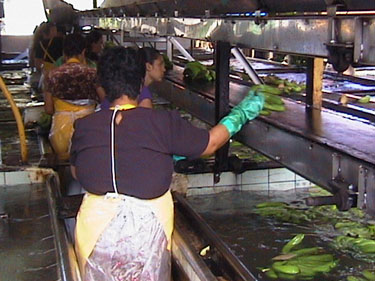
There were small simplistic
concrete buildings, all painted blue and white, with tin roofs. This must be
where the workers lived. We passed a small mini store with a few supplies, which
must be the company grocery and then the local school. All the children were
dressed in white shirts and navy blue skirts or pants, and white socks and black
shoes.
Then was passed acre after acre
of bananas. There were large ones, medium ones, small ones, and new startlings.
There were big long bunches of bananas hanging from the trunks and they were all
covered in blue bags, which I think was to keep the bugs away. The earth was a
deep rich red and the plants were in neat rows raised to allow for easy
irrigation. Along the road was a long metal track suspended off the ground
about 8 feet which we think was to hang the bananas so they wouldn’t get bruised
until the truck came by and picked them up.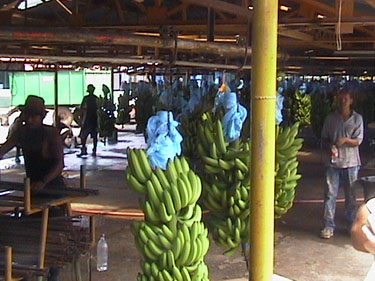
We passed warehouse with woman
workers hovering over conveyor belts loaded with bananas, picking bad ones out
and throwing them in bins. This was a big business and employed hundreds or
maybe thousands of people.
As we reached Chanquinola, we
decided we didn’t want to stop but just had the driver take us around town. He
did a good little tour though we couldn’t speak to each other much. He didn’t
really seem to know Spanish or English but only a few words that were important
to his business like “border”, “water taxi”, etc.
Chanquinola is not an
attractive town. The main street is filled with store after store filled with
clothes, shoes, and appliances, whatever these people need. He drove us by the
police station as two armed policemen were leaded two convicts in bright yellow
tee shirts, handcuffed to the courthouse. I’d say that all was pretty
entertaining.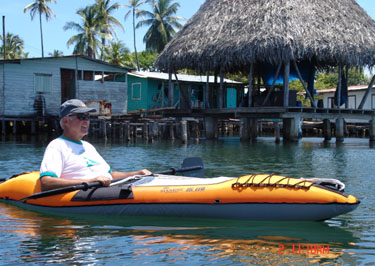
We got back in time to catch
the next water taxi back to Bocas. The ride back though identical was equally
entertaining. Same scenery but this time we had and elderly man with us that
had come to town to get a can of gasoline. He was so small that the can was
almost as big as he was and he could barely get it down to the dock. We stopped
at some mud hut mid way and managed to get him and the gas can off safely. His
two dogs came running out the wood plank from his hut very glad to see him. He
had some big black boots on that I’m sure he only wore to town because the rest
of the family was barefoot and muddy. He looked so out of place in those clumsy
boots and I think that’s why he was having so much trouble walking.
What a great day.
CAYO CARENERO
The archipelago de Bocas del
Toro, consists of six large islands and a scores of other little islands. The
biggest is Isla Colon on which Bocas Del Toro is situation. Directly at the
southeast end is Cayo Carenero. It’s much smaller and is so close to Bocas that
they seem as one. It’s an easy jaunt across the water to Cayo Carenero.
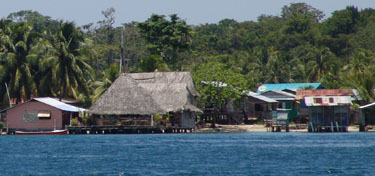
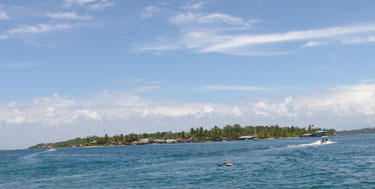
We spent quite a bit of time
over there. Tom, our new friend from Louisiana introduced us to a
small-protected area for swimming. The water is crystal clear and shallow or
you can go out further and snorkel. We’ve been going almost every afternoon. Ziggy goes along too and we’ve been teaching him to ride on his own on the
boogie board. He just floats around on it while we swim.
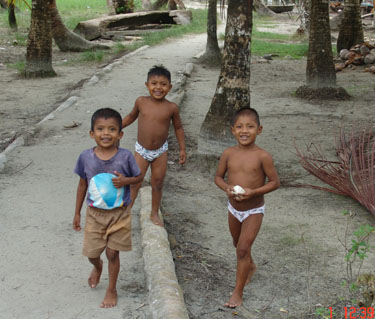
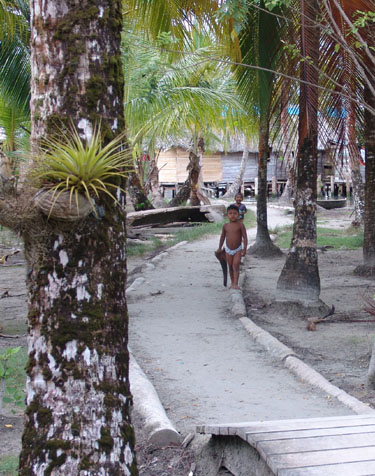
There’s a nice resort on the
shore and we dock the dinghy on their little pier and go in for margaritas. I
think they are the best margaritas since we’ve been south. It’s an open-air
palapa that is situated up over the water. Ziggy is allowed in and can sit at
the bar. We’ve had some fun times there.
The only other marina for this
area is on the other side of Cayo Carenero on the Bocas side. We rode the
dinghy over there one day to see what it was like. I must say we are extremely
happy that we decided to stay at Bocas Marina.
The docks here were wood and
rustic and it didn’t seem to have any nearby facilities. Right on the shore on
both sides of the pier, were native houses on poles over the low water. The
shore was just filled with garbage, it was really awful.
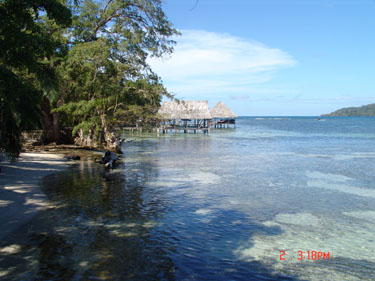 I love the natives and
their friendly children but I couldn’t stand to be near all that trash and the
sewage that goes right into the water from their shacks. It was too close. As
we walked past the native huts, the children wearing only enough to cover their
bottoms followed us. I took their picture and they loved seeing themselves
replayed on the LCD viewer. We checked out the Sunset Grill, which is said to
be part of the marina, but it is not that close. I love the natives and
their friendly children but I couldn’t stand to be near all that trash and the
sewage that goes right into the water from their shacks. It was too close. As
we walked past the native huts, the children wearing only enough to cover their
bottoms followed us. I took their picture and they loved seeing themselves
replayed on the LCD viewer. We checked out the Sunset Grill, which is said to
be part of the marina, but it is not that close.
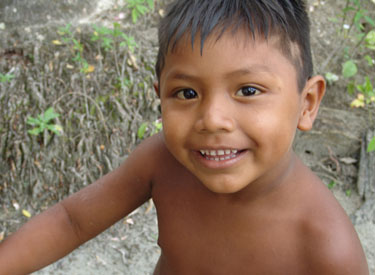
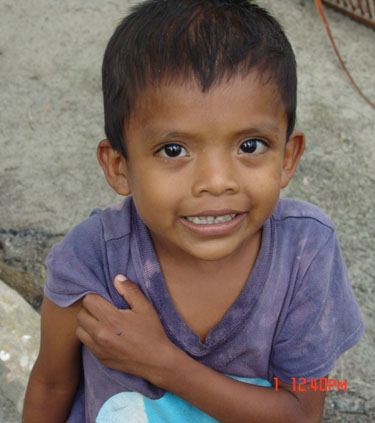
To get there you had to walk
through all the garbage and trash covered path. Once you got there, it was like
crossing a line from filth to pristine. It manicured, landscaped and clean.
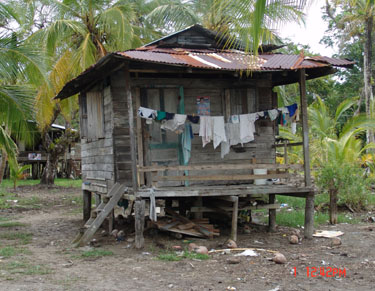
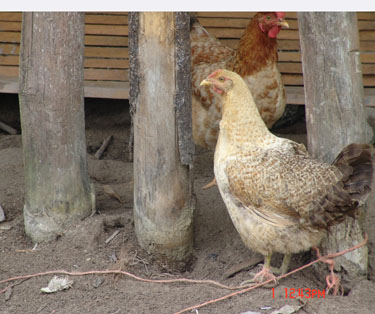
They had a few wooden cabanas available to rent and a palapa style restaurant
amidst flowered gardens. Tom said he ate their one night and he was the only
person. He said it was nice, he had some sort of Mexican dish, but the price
for a meal was higher than expected for the rest of Bocas. Maybe we were there
at the wrong time of the day and the minimal tide brought a huge amount of
trash in but this can’t compare to Bocas Marina. Although, our Italian
neighbors, mentioned that they felt the same way, there was no comparison
between the two marinas.
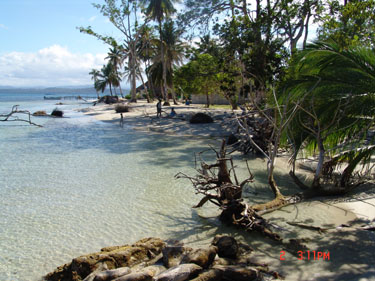
DAY-O, DAY-AY-AY-O
DAYLIGHT COME AND ME WAN’ GO
HOME
WELL I WORK BY SUN AND I SLEEP
BY MOON
WHEN I GET SOME MONEY GONNA
QUIT SO SOON
WELL I PACK MY THINGS AND I’LL
GO TO SEA
DEN DE BANANAS SEE THE LAST OF
ME
DAY-O, DAY-AY-AY-O
DAYLIGHT COME AND ME WAN’ GO
HOME
Day-O, Day-ay-ay-o
Daylight come and me wan’ go
home
Well I seen this place,
I'm wan' go on.
When capt’n
come, we'll leave at morn'n sun.
My things pack’d
, I'd be readyto go
Day-o, Day-ay-ay-o
Daylight come and me wan’ go
home
Now on to
Isla San Andreas
|
 We put Rains’ waypoints in to
enter the opening into Bocas Del Toro before we left Colon. We had called to
get a reservation at Bocas Yacht Club & Marina from Colon. We told them we’d be
in about 7:00. We said we would hail them on the radio when we got to the outer
buoy.
We put Rains’ waypoints in to
enter the opening into Bocas Del Toro before we left Colon. We had called to
get a reservation at Bocas Yacht Club & Marina from Colon. We told them we’d be
in about 7:00. We said we would hail them on the radio when we got to the outer
buoy.  We arrived right on schedule
and as we approached the outer buoy between Isla Colon and Isla Bastimentos we
hailed the marina but got no response. We decided to follow Rains waypoints and
head in to the buoy marked channels. It was pretty stressful at first because
Rains said to not follow the buoys, as they need to be replaced, due to silting
and movement due to earthquakes. Most of his comments were related to boats
drawing more than 10’ which ours does not but still I was a little concerned.
It just goes against the grain going outside the buoys. As we went in farther
and farther it became apparent that the area must be regularly dredged now as
the depths were well beyond 40 feet deep. (And after we were here for a few
days, we would see the huge Chiquita Banana Freighter and others going in and
out through this channel). As we passed most of the buoys and were close to the
south end of Cayo Carenero Island we were able to rouse someone from the
marina. They said to proceed on to red buoy 14 and then slowly turn right and
come straight towards the ferry dock. The voice on the radio said he would meet
us there in a launch and we could then follow him in to the Bocas Yacht Club
Marina.
We arrived right on schedule
and as we approached the outer buoy between Isla Colon and Isla Bastimentos we
hailed the marina but got no response. We decided to follow Rains waypoints and
head in to the buoy marked channels. It was pretty stressful at first because
Rains said to not follow the buoys, as they need to be replaced, due to silting
and movement due to earthquakes. Most of his comments were related to boats
drawing more than 10’ which ours does not but still I was a little concerned.
It just goes against the grain going outside the buoys. As we went in farther
and farther it became apparent that the area must be regularly dredged now as
the depths were well beyond 40 feet deep. (And after we were here for a few
days, we would see the huge Chiquita Banana Freighter and others going in and
out through this channel). As we passed most of the buoys and were close to the
south end of Cayo Carenero Island we were able to rouse someone from the
marina. They said to proceed on to red buoy 14 and then slowly turn right and
come straight towards the ferry dock. The voice on the radio said he would meet
us there in a launch and we could then follow him in to the Bocas Yacht Club
Marina.  We carefully followed
directions being aware that there are shallow areas here by the light blue color
of the waters. We saw Ricardo (the voice on the radio) waiting for us and he
lead us in to the marina by keeping snug to the buildings on our right for
several hundred yards and then we turned towards the marina.
We carefully followed
directions being aware that there are shallow areas here by the light blue color
of the waters. We saw Ricardo (the voice on the radio) waiting for us and he
lead us in to the marina by keeping snug to the buildings on our right for
several hundred yards and then we turned towards the marina.
 I had a great lobster
salad that was huge for $7.00 and Larry had a plate of Caribbean style chicken
and rice with vegetables. You can wash everything down with Panamanian beer
that goes down like water. They have a custom of bringing the beer to you with
a paper napkin cleverly curled around the top to keep the opening clean I
guess. They did that in Colon also.
I had a great lobster
salad that was huge for $7.00 and Larry had a plate of Caribbean style chicken
and rice with vegetables. You can wash everything down with Panamanian beer
that goes down like water. They have a custom of bringing the beer to you with
a paper napkin cleverly curled around the top to keep the opening clean I
guess. They did that in Colon also.  Bill and Elaine are always around and available and
making sure things are right. They have workers constantly manicuring the
grounds, painting, repairing and others to help the cruisers with whatever they
might need. Rosie does the laundry and charges by the load and things are
returned clean and professionally folded within hours. Ricardo does just about
everything and is a really nice guy. He brings his younger two brothers and
finds jobs for them too. Ricardo washed our boat when we arrived and cleaned
the underside of our boat. He takes the oil and dumps it when you change your
oil. He took our propane tank to Admiralty to fill it. He’s just great. He
helped an older Italian couple get their boat ready ad clean to leave it for 8
months here. He is a hard worker and solves all the problems. He’s an
enterprising young man and will go a long ways here.
Bill and Elaine are always around and available and
making sure things are right. They have workers constantly manicuring the
grounds, painting, repairing and others to help the cruisers with whatever they
might need. Rosie does the laundry and charges by the load and things are
returned clean and professionally folded within hours. Ricardo does just about
everything and is a really nice guy. He brings his younger two brothers and
finds jobs for them too. Ricardo washed our boat when we arrived and cleaned
the underside of our boat. He takes the oil and dumps it when you change your
oil. He took our propane tank to Admiralty to fill it. He’s just great. He
helped an older Italian couple get their boat ready ad clean to leave it for 8
months here. He is a hard worker and solves all the problems. He’s an
enterprising young man and will go a long ways here. I guess they come and fall in love with it and decide not to
eave – that simple.
I guess they come and fall in love with it and decide not to
eave – that simple. An old guy with a white beard lives on it. He’s got a
barrel-sized chest, arms like a 20 yr old and is missing his front teeth.
Apparently he is a treasure hunter by trade. He must have done well from the
size of his boat. He said he found an Old Spanish galleon off the coast of
Texas in the 60’s. There’s another treasure hunter at the end of our dock. His
boat is a little funkier looking but is more like a working vessel. Tom told us
that he has done some research diving in the Rio Dulce area in Guatemala for
National Geographic and the Smithsonian Institute. Everyone says he’s
scavenging around the area and so far has only found old bottles and such. This
area has a lot of history and Columbus had been known to frequent the island and
use the shallow waters to do repairs on their sailing ships. It also was a
haunt for pirates at one time too. In fact, one morning the marina found an old
anchor on the bottom near our boat. They hauled it out and it’s now serving as
a conversation piece at the bar.
An old guy with a white beard lives on it. He’s got a
barrel-sized chest, arms like a 20 yr old and is missing his front teeth.
Apparently he is a treasure hunter by trade. He must have done well from the
size of his boat. He said he found an Old Spanish galleon off the coast of
Texas in the 60’s. There’s another treasure hunter at the end of our dock. His
boat is a little funkier looking but is more like a working vessel. Tom told us
that he has done some research diving in the Rio Dulce area in Guatemala for
National Geographic and the Smithsonian Institute. Everyone says he’s
scavenging around the area and so far has only found old bottles and such. This
area has a lot of history and Columbus had been known to frequent the island and
use the shallow waters to do repairs on their sailing ships. It also was a
haunt for pirates at one time too. In fact, one morning the marina found an old
anchor on the bottom near our boat. They hauled it out and it’s now serving as
a conversation piece at the bar. Zig has managed to get along
with the resident dog and another cruiser’s dog, a golden lab, name “Elvis”.
They are both about the easiest going dogs and have not been bothered by Zig’s
idiosyncrasies. It’s fun to watch each afternoon as everyone gathers for happy
hour and the dogs gather too and play. One day, we didn’t go down or were late,
and the little resident marina dog came to the boat and barked for Ziggy to come
out. When they get hot from playing too much, they wade into the clear water by
the bar.
Zig has managed to get along
with the resident dog and another cruiser’s dog, a golden lab, name “Elvis”.
They are both about the easiest going dogs and have not been bothered by Zig’s
idiosyncrasies. It’s fun to watch each afternoon as everyone gathers for happy
hour and the dogs gather too and play. One day, we didn’t go down or were late,
and the little resident marina dog came to the boat and barked for Ziggy to come
out. When they get hot from playing too much, they wade into the clear water by
the bar.  Everyone here understands Zig and knows he’s a little eccentric but
they don’t mind. They all call him by name and he is having a ball here. If
something around the marina doesn’t look normal, the three dogs all join
together to investigate and bark to announce to all that something isn’t right.
One day a huge boat came in, about 120 ‘, and they immediately got down their
obnoxious jet skis and were
Everyone here understands Zig and knows he’s a little eccentric but
they don’t mind. They all call him by name and he is having a ball here. If
something around the marina doesn’t look normal, the three dogs all join
together to investigate and bark to announce to all that something isn’t right.
One day a huge boat came in, about 120 ‘, and they immediately got down their
obnoxious jet skis and were
 making noise and racing around. None of the rest of
us liked it nor did the dogs I guess because they were the only ones with balls
enough to tell them.
making noise and racing around. None of the rest of
us liked it nor did the dogs I guess because they were the only ones with balls
enough to tell them.  So, we have not
put the water in our water tank and decided to put several gallons of purified
bottled water in the tank until we leave. The water looks clean in the marina
but it goes against our grain to make water in a marina. Also, when I kayaked
around the corner in the mangroves there are several settlements of native
Indians that are dumping in the water and it doesn’t look too clean.
So, we have not
put the water in our water tank and decided to put several gallons of purified
bottled water in the tank until we leave. The water looks clean in the marina
but it goes against our grain to make water in a marina. Also, when I kayaked
around the corner in the mangroves there are several settlements of native
Indians that are dumping in the water and it doesn’t look too clean.  Our neighbors got their
dinghy back but the cables to the engine had been damaged and they had to order
new ones from the states. Apparently, when they steel these dinghies they are
after the motors and they can’t cut the cables on the newer ones. So I guess
they abandoned the dinghy after several tries to remove the motor and were
unsuccessful.
Our neighbors got their
dinghy back but the cables to the engine had been damaged and they had to order
new ones from the states. Apparently, when they steel these dinghies they are
after the motors and they can’t cut the cables on the newer ones. So I guess
they abandoned the dinghy after several tries to remove the motor and were
unsuccessful. BOCAS THE TOWN, It’s a real mix
BOCAS THE TOWN, It’s a real mix




 The fancier ones had a make shift sunscreen. Most
had multiple wooden planks to sit on. We saw one that must have been not more
than four feet wide and about 25 feet long. Many are painted in bright colors.
They can maneuver those things into the narrowest places like you wouldn’t
believe. Then there were the water taxis that took you to Almirante,
Bastiamentos, or Chanquinola. They were bigger in that they were wider. You
could squeeze in about four people wide and five or six rows. They were covered
in a low canvas awning and you had to crouch to get in them. Those little
stinkers could go up to 30 knots and within a short while you could be on the
mainland. Mostly natives and residents getting business done in Almirante used
those. Last but certainly not the least, were the dugout canoes. The Indians
or natives in the area used these. They were as commonplace as any of the other
modes of transportation. They were carved as you would imagine from one single
log and the paddle was handmade also. There were a rare few that would have an
outboard motor on it with a few gas cans inside. Mostly they were small and
held one or two people and one baby. They were commonplace, but I thought they
were charming. I was never bored at the site of them. I was just amazed at the
mix of everything.
The fancier ones had a make shift sunscreen. Most
had multiple wooden planks to sit on. We saw one that must have been not more
than four feet wide and about 25 feet long. Many are painted in bright colors.
They can maneuver those things into the narrowest places like you wouldn’t
believe. Then there were the water taxis that took you to Almirante,
Bastiamentos, or Chanquinola. They were bigger in that they were wider. You
could squeeze in about four people wide and five or six rows. They were covered
in a low canvas awning and you had to crouch to get in them. Those little
stinkers could go up to 30 knots and within a short while you could be on the
mainland. Mostly natives and residents getting business done in Almirante used
those. Last but certainly not the least, were the dugout canoes. The Indians
or natives in the area used these. They were as commonplace as any of the other
modes of transportation. They were carved as you would imagine from one single
log and the paddle was handmade also. There were a rare few that would have an
outboard motor on it with a few gas cans inside. Mostly they were small and
held one or two people and one baby. They were commonplace, but I thought they
were charming. I was never bored at the site of them. I was just amazed at the
mix of everything.
 There were wood planked paths
over the walked to get you from your boat to the street. Some buildings were
mostly accessible from the water rather than the street. To reach some places
you would have to walk down a rickety-planked pathway between buildings. Some
places didn’t have signs you just had to know where it. Many signs throughout
the town were unintentionally misspelled which was comical.
There were wood planked paths
over the walked to get you from your boat to the street. Some buildings were
mostly accessible from the water rather than the street. To reach some places
you would have to walk down a rickety-planked pathway between buildings. Some
places didn’t have signs you just had to know where it. Many signs throughout
the town were unintentionally misspelled which was comical. 
 There
are many small hotels with simple minimal comforts and a few new very small
European style hotels over the water. There are a handful of general stores
that I can only compare to something out of the old west. They had old wooden
counters with glass fronts surrounding the room and tall ceilings with goods
stacked the full width and height. Some have old-fashioned scales hanging above
the counter to weigh something.
There
are many small hotels with simple minimal comforts and a few new very small
European style hotels over the water. There are a handful of general stores
that I can only compare to something out of the old west. They had old wooden
counters with glass fronts surrounding the room and tall ceilings with goods
stacked the full width and height. Some have old-fashioned scales hanging above
the counter to weigh something.  If you wanted something you had to ask the clerk to get it
for you or point to it if they didn’t understand. Each general store had a
little of this and a little of that. If you were looking for Ajax or something
like that, one store might have 2 bottles and another not have any. It was a
fun excursion just walking around town just having something to look whether you
needed it or not.
If you wanted something you had to ask the clerk to get it
for you or point to it if they didn’t understand. Each general store had a
little of this and a little of that. If you were looking for Ajax or something
like that, one store might have 2 bottles and another not have any. It was a
fun excursion just walking around town just having something to look whether you
needed it or not.
 It was like a treasure hunt. I also loved walking on their
old plank floors because they were so irregular. Some of the planks would sink
slightly and others were crooked. Some would be missing and would be covered
with any old thing nailed tight. You would find everything from tools, nails in
bins (you could even buy one instead of a package that you didn’t need like at
Home Depot), to clothes, cloth, cooking oil, dishes, rice, just everything, but
probably not the one particular thing you were looking for. The fun part was
just looking for it.
It was like a treasure hunt. I also loved walking on their
old plank floors because they were so irregular. Some of the planks would sink
slightly and others were crooked. Some would be missing and would be covered
with any old thing nailed tight. You would find everything from tools, nails in
bins (you could even buy one instead of a package that you didn’t need like at
Home Depot), to clothes, cloth, cooking oil, dishes, rice, just everything, but
probably not the one particular thing you were looking for. The fun part was
just looking for it. 

 If you fall off the dock at the restaurant your eating at, it’s still your own
fault. If the building collapses that you’re eating in because it’s leaning way
too far on it’s side, it’s surely your fault. If you get bit by a dog, well, no
one knows who’s dog it is, so what’s the problem and also the dogs are so dossal
here that they wouldn’t even consider that. But if you steal, or hurt someone,
or do drugs, watch out because you’re thrown in the clinker for three months
regardless the charge. It’s a lot like the old west and I love it. It’s still
functioning in the old days when people were responsible for their own actions.
We are so worried about everything because we might get sued, but not here. If
there’s an old shack on it’s last legs, don’t worry about it, open it up and
start a restaurant. If you don’t buy furniture, just make it out of whatever’s
around, and it doesn’t matter if it’s not straight or too sturdy. One night we
ate at the Pescador Sabor on the second floor outside on the balcony. The
building was slanting so much I was worried about it falling over while we were
eating. Larry said the balcony would probably collapse under us first before
the building. The chairs were hand made and the table-top kept flipping up
since it was a piece of board wedged in the railing and on top of a post. They
covered it in a piece of oilcloth. We finally had to move to another table
because it would have flipped our food across the room if Larry forgot and put
his elbows down too hard.
If you fall off the dock at the restaurant your eating at, it’s still your own
fault. If the building collapses that you’re eating in because it’s leaning way
too far on it’s side, it’s surely your fault. If you get bit by a dog, well, no
one knows who’s dog it is, so what’s the problem and also the dogs are so dossal
here that they wouldn’t even consider that. But if you steal, or hurt someone,
or do drugs, watch out because you’re thrown in the clinker for three months
regardless the charge. It’s a lot like the old west and I love it. It’s still
functioning in the old days when people were responsible for their own actions.
We are so worried about everything because we might get sued, but not here. If
there’s an old shack on it’s last legs, don’t worry about it, open it up and
start a restaurant. If you don’t buy furniture, just make it out of whatever’s
around, and it doesn’t matter if it’s not straight or too sturdy. One night we
ate at the Pescador Sabor on the second floor outside on the balcony. The
building was slanting so much I was worried about it falling over while we were
eating. Larry said the balcony would probably collapse under us first before
the building. The chairs were hand made and the table-top kept flipping up
since it was a piece of board wedged in the railing and on top of a post. They
covered it in a piece of oilcloth. We finally had to move to another table
because it would have flipped our food across the room if Larry forgot and put
his elbows down too hard. I have to remember to tell you
about this little Indian kid in town before I forget. The first day we arrived
and walked down the main street, this little kid walked up to Larry and pulled
on his shirttail and muttered something. He was probably only about eight years
old, bare foot and clothes that were so brown that they must be washed in the
muddy water. He had a hand made wooden box that was hung on his shoulder across
his chest with an old woven piece of banding. I finally figured out he was
asking Larry if he wanted a shoeshine. We were hurrying to get Dave to the
airport so Larry said another day. Now trying to find someone in this town to
give a shoeshine to is about as hard as trying to sell a wool muffler to someone
in the desert. It’s hot here and everyone where’s sandals or is barefoot. Poor
little guy, trying to earn some money, someone ought to give another idea.
I have to remember to tell you
about this little Indian kid in town before I forget. The first day we arrived
and walked down the main street, this little kid walked up to Larry and pulled
on his shirttail and muttered something. He was probably only about eight years
old, bare foot and clothes that were so brown that they must be washed in the
muddy water. He had a hand made wooden box that was hung on his shoulder across
his chest with an old woven piece of banding. I finally figured out he was
asking Larry if he wanted a shoeshine. We were hurrying to get Dave to the
airport so Larry said another day. Now trying to find someone in this town to
give a shoeshine to is about as hard as trying to sell a wool muffler to someone
in the desert. It’s hot here and everyone where’s sandals or is barefoot. Poor
little guy, trying to earn some money, someone ought to give another idea. There’s one small place with a
hand painted sign out front called “Costco”. It can’t be any bigger than 10-12
feet wide and 20 feet deep and most of the wares are stacked on the street. He
sells in bulk. In other words, if you want a coke you buy a flat of cokes, or
rice, you buy a box of 20 packages of rice. I think you could save 2 cents.
We didn’t find much use for that place but loved the name.
There’s one small place with a
hand painted sign out front called “Costco”. It can’t be any bigger than 10-12
feet wide and 20 feet deep and most of the wares are stacked on the street. He
sells in bulk. In other words, if you want a coke you buy a flat of cokes, or
rice, you buy a box of 20 packages of rice. I think you could save 2 cents.
We didn’t find much use for that place but loved the name.

 There is one place that touts
the name of “Gourmet Market” owned by a transplant from Louisiana. There you
can find some amazing things that you won’t see in the local stores, like
camembert, feta cheese, frozen scallops, tortillas, many canned goods, etc.
She also carries fresh bread and cinnamon rolls from the local European Bakery
that we discovered late in the game that makes the best stuff.
There is one place that touts
the name of “Gourmet Market” owned by a transplant from Louisiana. There you
can find some amazing things that you won’t see in the local stores, like
camembert, feta cheese, frozen scallops, tortillas, many canned goods, etc.
She also carries fresh bread and cinnamon rolls from the local European Bakery
that we discovered late in the game that makes the best stuff. 


 In fact our intention is to find a fancy meal. The fanciest we found was
at the original United Fruit Company Hotel near the plaza. This place is very
small but has been meticulously restored by the present owner to its full
“rustic splendor” of the old days. We loved sitting out on the front porch,
practically on the street and enjoying a real glass of Chilean wine and
wonderful Italian food. We could watch the world go by and our waiter (the only
water) who preferred being called “Nino” rather than his real name “Jesus” was
friendly and waited on us like we were his only customer (which we usually
were). We also enjoyed the “Ballena” next door that coincidently served
“authentic” Italian food also.
In fact our intention is to find a fancy meal. The fanciest we found was
at the original United Fruit Company Hotel near the plaza. This place is very
small but has been meticulously restored by the present owner to its full
“rustic splendor” of the old days. We loved sitting out on the front porch,
practically on the street and enjoying a real glass of Chilean wine and
wonderful Italian food. We could watch the world go by and our waiter (the only
water) who preferred being called “Nino” rather than his real name “Jesus” was
friendly and waited on us like we were his only customer (which we usually
were). We also enjoyed the “Ballena” next door that coincidently served
“authentic” Italian food also.  Some of the restaurants are for the natives and they
are mixed in with everything else in town. One day I saw a guy cooking on a
card table. He had a big bucket of soup ad some meat on a charcoal grill. He
has a few chairs and crates for a table. There’s another place near the plaza
that cooks BBQ’d chicken and serves it to you in a brown paper bag. Everything
works, not matter what style.
Some of the restaurants are for the natives and they
are mixed in with everything else in town. One day I saw a guy cooking on a
card table. He had a big bucket of soup ad some meat on a charcoal grill. He
has a few chairs and crates for a table. There’s another place near the plaza
that cooks BBQ’d chicken and serves it to you in a brown paper bag. Everything
works, not matter what style. What’s really great
is that everybody mixes with everybody. There is no friction that I can see. They all mix together and seem a happy bunch.
What’s really great
is that everybody mixes with everybody. There is no friction that I can see. They all mix together and seem a happy bunch. The whole town knew about the theft and kept an eye out for the thief.
The next day the dinghy was found near the airport and returned and we heard the
culprit was thrown in jail. They say they don’t tolerate things like that here.
The whole town knew about the theft and kept an eye out for the thief.
The next day the dinghy was found near the airport and returned and we heard the
culprit was thrown in jail. They say they don’t tolerate things like that here.
 on the Island
of Colon, which is one of a cluster of beautiful island here. The waters are
crystal clear if there have been no rains causing the many rivers to dump silt
into the area. The surfing is said to be great also. One of the islands touts
the rare red frog that is only found there and no where else on this planet.
There are many nearby excursions that are very inexpensive to snorkel and go to
pristine beaches.
on the Island
of Colon, which is one of a cluster of beautiful island here. The waters are
crystal clear if there have been no rains causing the many rivers to dump silt
into the area. The surfing is said to be great also. One of the islands touts
the rare red frog that is only found there and no where else on this planet.
There are many nearby excursions that are very inexpensive to snorkel and go to
pristine beaches.
 In the late 1800’s the Snyder
Bros. Started cutting a channel parallel to the ocean to barge out the bananas
from the vast banana plantations here. The channel is about 15 km long and is
amazing. It’s about 40 wide at the widest part and cut straight through the
jungle. Not realizing this is a great tourist ride, the local water taxi
service offers a quick trip up to Chanquinola through this channel. Many locals
use it to get the Chanquinola that has a lot of local shopping and also another
30-minute taxi ride people can get to the border of Costa Rica. Those who are
transplants living here have to get out of the country every 90 days for 72
hours. At this borders for $20, under the table, they can get their passports
stamped and turn right around and get back to Bocas in another hour with out
having to stay overnight in Costa Rica. Today we used it for an adventure
ride.
In the late 1800’s the Snyder
Bros. Started cutting a channel parallel to the ocean to barge out the bananas
from the vast banana plantations here. The channel is about 15 km long and is
amazing. It’s about 40 wide at the widest part and cut straight through the
jungle. Not realizing this is a great tourist ride, the local water taxi
service offers a quick trip up to Chanquinola through this channel. Many locals
use it to get the Chanquinola that has a lot of local shopping and also another
30-minute taxi ride people can get to the border of Costa Rica. Those who are
transplants living here have to get out of the country every 90 days for 72
hours. At this borders for $20, under the table, they can get their passports
stamped and turn right around and get back to Bocas in another hour with out
having to stay overnight in Costa Rica. Today we used it for an adventure
ride.




 r activated to the maximum
again. e passed some villagers, trying to hug the side of the channel to make
way for our wake. They were coming from Chanquinola I imagined with some
supplies.
r activated to the maximum
again. e passed some villagers, trying to hug the side of the channel to make
way for our wake. They were coming from Chanquinola I imagined with some
supplies. 






 I love the natives and
their friendly children but I couldn’t stand to be near all that trash and the
sewage that goes right into the water from their shacks. It was too close. As
we walked past the native huts, the children wearing only enough to cover their
bottoms followed us. I took their picture and they loved seeing themselves
replayed on the LCD viewer. We checked out the Sunset Grill, which is said to
be part of the marina, but it is not that close.
I love the natives and
their friendly children but I couldn’t stand to be near all that trash and the
sewage that goes right into the water from their shacks. It was too close. As
we walked past the native huts, the children wearing only enough to cover their
bottoms followed us. I took their picture and they loved seeing themselves
replayed on the LCD viewer. We checked out the Sunset Grill, which is said to
be part of the marina, but it is not that close. 



